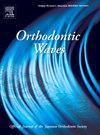透明矫正器材料上正畸按钮的结合强度
IF 0.5
Q4 DENTISTRY, ORAL SURGERY & MEDICINE
引用次数: 1
摘要
摘要目的评价用正畸塑料胶粘剂粘接在各种透明矫正器材料上的正畸按钮的剪切粘接强度。材料和方法使用正畸塑料粘合剂(Bond-aligner®)将三种类型的热塑性材料:1)Duran(聚对苯二甲酸乙二醇酯)、2)Essix A+(聚对苯二甲酸丙二醇酯)和3)Zendura(聚氨酯)与金属或塑料按钮粘合。制备了6个实验组,每组15个样本。根据搭接剪切试验方法(ASTM D3163)使用通用试验机进行粘结强度试验。结合失效模式(根据ASTM D5573修改)用立体镜检查。Kruskal-Wallis和事后试验用于分析六组之间剪切粘结强度的差异。结果平均粘结强度为:1)杜兰金属(DM)(7.04MPa);2) 杜兰塑性(DP)(5.37MPa);3) Essix金属(EM)(5.55MPa);4) Essix塑料(EP)(4.62MPa);5) Zendura金属(ZM)(1.17MPa);和6)Zendura塑料(ZP)(1.40MPa)。三种热塑性材料之间的剪切粘合强度显著不同(p<0.05)。对于粘合失效模式,无论按钮类型如何,Duran和Essix A+都显示出热塑性片材的基底失效,而Zendura在热塑性板材界面处显示出粘合失效。结论用口腔正畸塑料粘合剂粘接Duran和Essix A+口腔正畸按钮,可获得很高的粘接强度,热塑性塑料片在按钮脱离前会撕裂。与Zendura粘合的纽扣导致了显著更高的粘合失败率。本文章由计算机程序翻译,如有差异,请以英文原文为准。
Bond strength of orthodontic buttons on clear aligner materials
ABSTRACT Purpose To evaluate the shear bond strength of orthodontic buttons bonded on various clear aligner materials using orthodontic plastic adhesive. Materials and methods Three types of thermoplastic materials: 1) Duran (Polyethylene terephthalate glycol), 2) Essix A+ (Polyethylene terephthalate glycol), and 3) Zendura (Polyurethane) were bonded with either metal or plastic buttons using orthodontic plastic adhesive (Bond aligner®). Six experimental groups with 15 specimens per group were prepared. Bond strength testing was done according to the Lap Shear Test Method (ASTM D3163) using the universal testing machine. Bond failure mode (modified from ASTM D5573) was examined with a stereoscope. Kruskal-Wallis and post hoc tests were used to analyse the differences in shear bond strength among the six groups. Results Mean bond strengths were as follows: 1) Duran-metal (DM) (7.04 MPa); 2) Duran-plastic (DP) (5.37 MPa); 3) Essix-metal (EM) (5.55 MPa); 4) Essix-plastic (EP) (4.62 MPa); 5) Zendura-metal (ZM) (1.17 MPa); and 6) Zendura-plastic (ZP) (1.40 MPa). Shear bond strength among the three thermoplastic materials were significantly different (p < .05). For the bond failure mode, regardless of button type, Duran and Essix A+ showed substrate failure of the thermoplastic sheet, while Zendura showed adhesive failure at the thermoplastic sheet interface. Conclusion Orthodontic buttons bonded on Duran and Essix A+ using orthodontic plastic adhesive could achieve very high bond strength that the thermoplastic sheets would tear before button detachment occurred. Buttons bonded to Zendura resulted in significantly greater bond failure rates.
求助全文
通过发布文献求助,成功后即可免费获取论文全文。
去求助
来源期刊

Orthodontic Waves
DENTISTRY, ORAL SURGERY & MEDICINE-
CiteScore
0.40
自引率
0.00%
发文量
0
期刊介绍:
Orthodontic Waves is the official publication of the Japanese Orthodontic Society. The aim of this journal is to foster the advancement of orthodontic research and practice. The journal seeks to publish original articles (i) definitive reports of wide interest to the orthodontic community, (ii) Case Reports and (iii) Short Communications. Research papers stand on the scientific basis of orthodontics. Clinical topics covered include all techniques and approaches to treatment planning. All submissions are subject to peer review.
 求助内容:
求助内容: 应助结果提醒方式:
应助结果提醒方式:


